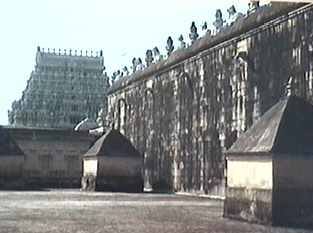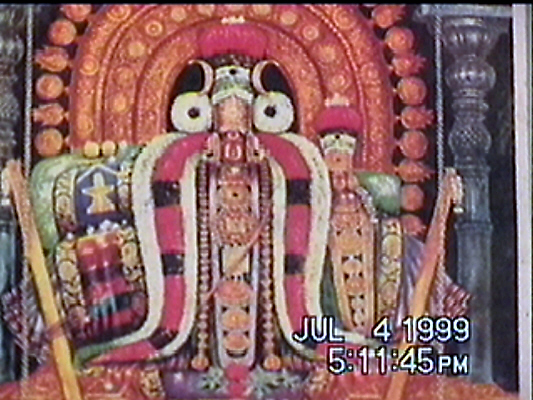| Located near Thanjavur in Tamilnadu, Tiruvarur is an ancient shrine steeped in
mysticism. It is rich in legend, history and tradition. |
Tiruvarur Temple History: Trace the history of Tiruvarur through insights
gained from the Tevaram hymns, temple inscriptions and other sources. |
Tiruvarur Deities:
Vanmikanathar represents the Moolavar while the shrine dedicated to Tyagaraja is the
better known shrine in the temple. |
| The Vanmikanathar
Legend relates to Shiva appearing within an anthill in response to prayers from the Gods. |

|
Legend
has it that the Tyagaraja (Somaskanda) image at Tiruvarur was created and worshipped by
Maha Vishnu. Somaskanda is symbolic of fertility, of royal lineage etc. |
| Somaskanda Iconography: Somaskanda refers to a manifestation
of Shiva with Skanda and Uma by his side. |
Tyagaraja
represents the Somaskanda manifestation of Shiva at Tiruvarur and at a few other shrines.
Tyagarajar is referred to as Veedhi Vitankar in the Tevaram hymns. |
The
Tyagaraja Shrine at Tiruvarur is steeped in mysticism. Tyagaraja is
associated with the Ajapaa Natanam. |
| Ajapaa
Natanam is associated with the dance of the image of Somaskanda worn by
Vishnu, in synch with his breath. |
Mucukunda
Chola Legend: The valorous Chola king brought back from Indra 7 images of
Somaskanda. |
Sapta
Vitanka Shrines refer to seven temples in the Chola kingdom enshrining images
of Tyagaraja brought to earth by Mucukunda Chakravarti. |
| Tiruvarur
Temple Layout: The vast temple complex at Tiruvarur with several shrines has
many spacious mandapams and towering gopurams. |
 |
Tevaram
hymns dedicated to Tiruvarur describe festivities in the temple town during the 1st
millennium CE. 62 of the Nayanmaar preceding Sundarar are mentioned in Tiruttondattokai. |
| Miracles
associated with the lives of other Saivite Saints at Tiruvarur. Naminandi Adikal, Dandi
Adikal and Somaasi Maaranaar are some of the other saints associated with Tiruvarur. |
Visit our earlier feature on
the Sapta Vitanka shrines in the ancient
Chola Kingdom of Tamilnadu. |
Visit our earlier feature on
Tiruvarur (in conjunction with Abodes of Shiva
- published in October 1999). |


